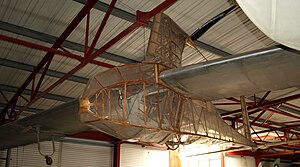SUMPAC
| SUMPAC | |
|---|---|

| |
| SUMPAC on display at the Solent Sky museum. | |
| Role | Human-powered aircraft |
| First flight | 9 November 1961 |
| Number built | 1 |
The Southampton University Man Powered Aircraft (or SUMPAC) on 9 November 1961 became the first human-powered aeroplane to make an officially authenticated take-off and flight.[1] It was designed and built by Southampton university students between 1960 and 1961 for an attempt at the Kremer prize, but it was never able to complete the 'figure-of-eight' course specified to claim the prize money.[2]
Design and development[edit]
The aircraft was designed and built by a team of post-graduate students from Southampton University. Intended to compete for the £50,000 Kremer Prize (requiring successful completion of a one-mile (1.6 km) 'figure of eight' course) the project was funded by the Royal Aeronautical Society.[2]
The aircraft is of conventional configuration, with the exception of a pylon mounted pusher propeller, and is constructed from balsa, plywood and aluminium alloy. Originally covered with silver-doped Nylon the aircraft now sports a transparent plastic skin on the fuselage.
The SUMPAC was powered using pedals and chains to drive a large two-bladed propeller. Piloted by noted gliding instructor and test pilot Derek Piggott, its first flight on 9 November 1961 at Lasham airfield covered a distance of 70 yards (64 m) and climbed to a height of six feet (1.8 m).[2] The longest flight made was 650 yards (594 m) rising to a maximum height of 15 ft (4.6 m). Turns were attempted, with 80 degrees the best achieved. A total of 40 flights were made by SUMPAC.[3] After a crash in 1963 which caused damage to the fragile structure it was decided to retire the aircraft although it had been repaired.[2]
The SUMPAC is currently on display at the Solent Sky museum; it was loaned for some time to the Shuttleworth Collection but now resides in its hometown of Southampton.
Specifications (SUMPAC)[edit]
Data from The World's Sailplanes:Die Segelflugzeuge der Welt:Les Planeurs du Monde Volume II[2][4][5]
General characteristics
- Crew: 1
- Length: 24 ft 9 in (7.54 m)
- Wingspan: 80 ft 1 in (24.4 m)
- Wing area: 300 sq ft (27.9 m2)
- Aspect ratio: 21.3
- Airfoil: NACA 65a 818
- Empty weight: 128 lb (58.1 kg)
- Gross weight: 268 lb (121.6 kg)
Performance
- Never exceed speed: 21 mph (33 km/h, 18 kn)
- g limits: +1.5 -1 at 26.4 km/h (16.4 mph; 14.3 kn)
- Maximum glide ratio: 34 at 105 km/h (65.2 mph; 56.7 kn)
- Rate of sink: 37 ft/min (0.19 m/s) at 27 km/h (16.8 mph; 14.6 kn)
- Lift-to-drag: 36 at 32 km/h (19.9 mph; 17.3 kn)
- Wing loading: 0.89 lb/sq ft (4.35 kg/m2)
See also[edit]
Aircraft of comparable role, configuration, and era
- HMPAC Puffin
- HPA Toucan
- Malliga 1
- MacCready Gossamer Albatross
- MacCready Gossamer Condor
- Goodhart Newbury Manflier
- Southend MPG Mayfly
References[edit]
Notes[edit]
- ^ "BBC News web-site". Retrieved 15 November 2012.
- ^ a b c d e Guttery 1969, p. 70.
- ^ Details of SUMPAC
- ^ Shenstone, B.S.; K.G. Wilkinson (1963). The World's Sailplanes:Die Segelflugzeuge der Welt:Les Planeurs du Monde Volume II (in English, French, and German) (1st ed.). Zurich: Organisation Scientifique et Technique Internationale du Vol a Voile (OSTIV) and Schweizer Aero-Revue. pp. 120–121.
- ^ Flight International, 23 December 1971 p1014
Bibliography[edit]
- Shenstone, B.S.; K.G. Wilkinson (1963). The World's Sailplanes:Die Segelflugzeuge der Welt:Les Planeurs du Monde Volume II (in English, French, and German) (1st ed.). Zurich: Organisation Scientifique et Technique Internationale du Vol a Voile (OSTIV) and Schweizer Aero-Revue. pp. 34–36.
- Guttery, T.E. The Shuttleworth Collection. London: Wm. Carling & Co, 1969. SBN 901319-01-5
- Man powered flight advances
